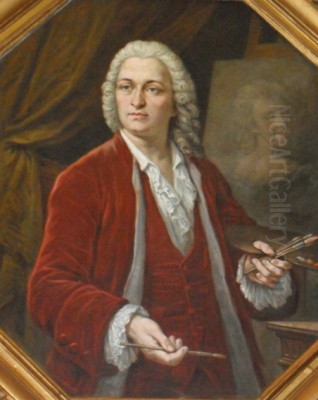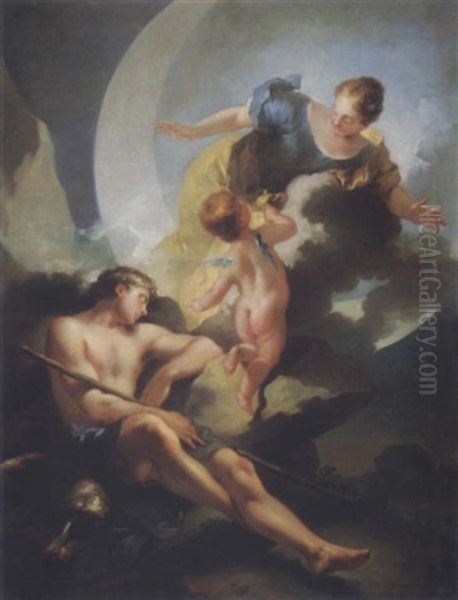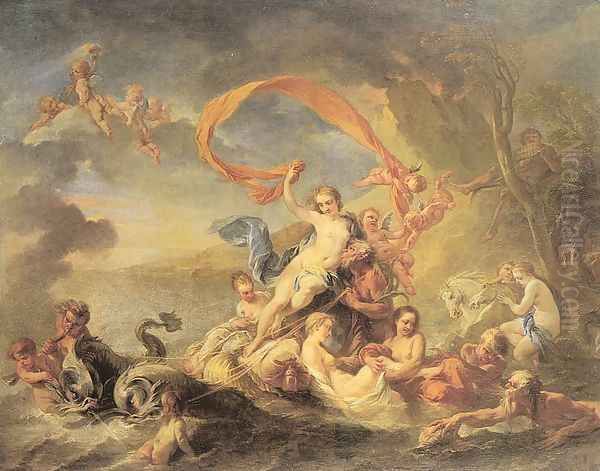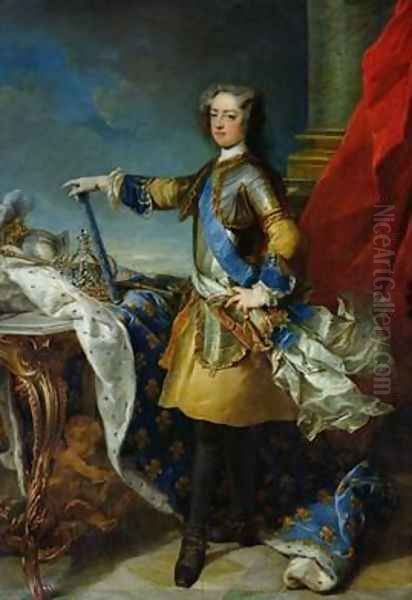Introduction: An Artist of European Renown

Jean-Baptiste van Loo stands as a significant figure in the landscape of 18th-century European art. Born in Aix-en-Provence, France, in 1684, he hailed from a distinguished lineage of artists of Dutch descent who left an indelible mark on French painting. Primarily celebrated for his exceptional skill in portraiture and his contributions to historical painting, Van Loo navigated the artistic currents of his time with remarkable success, becoming a favoured painter of royalty and aristocracy across the continent. His life and career reflect the cosmopolitan nature of the art world during the Rococo period, marked by extensive travel, prestigious commissions, and influential academic positions. He died in his hometown in 1745, leaving behind a rich legacy carried on by his talented family members.
Early Life and Artistic Formation
Jean-Baptiste van Loo's artistic journey began under the tutelage of his father, Louis-Abraham van Loo, himself a painter. The Van Loo family, originally Flemish, had established a strong artistic tradition. Growing up in Aix-en-Provence, Jean-Baptiste absorbed the fundamentals of drawing and painting within this familial environment. His early training instilled in him the technical proficiency and dedication that would characterize his later career. The artistic atmosphere of southern France, combined with the family's artistic heritage, provided a fertile ground for his burgeoning talent.
Following his father's guidance, the young artist quickly demonstrated promise. His formative years were shaped not only by direct instruction but also by the study of works accessible to him. The artistic environment of Aix, though perhaps not as central as Paris, offered exposure to various influences, likely including Italian and French Baroque traditions. This foundational period was crucial in developing the technical skills and artistic sensibilities that would later define his mature style, preparing him for a career that would extend far beyond his native Provence.
Italian Travels and Artistic Development

Like many ambitious artists of his era, Jean-Baptiste van Loo recognized the importance of Italy as a centre for artistic learning and inspiration. He embarked on a journey south, spending significant time in key Italian cities, including Turin, Rome, and Genoa. This period was instrumental in refining his technique and broadening his artistic horizons. In Italy, he immersed himself in the study of the Italian masters, absorbing lessons from both Renaissance and Baroque art, which profoundly influenced his approach to composition, colour, and form.
In Rome, the epicentre of the classical tradition and Baroque innovation, Van Loo further honed his skills. He reportedly studied with notable artists such as Benedetto Luti, a respected painter known for his soft sfumato and graceful figures, bridging the gap between late Baroque and early Rococo sensibilities. Exposure to the works of sculptors like Pierre Le Gros the Younger and the grandeur of Roman art, both ancient and contemporary, enriched his understanding of anatomy, drapery, and dramatic expression. His time in Italy was not merely educational; he also undertook commissions, including religious works like the reported Flagellation of Christ for the church of Santa Maria in Monticelli, demonstrating his versatility beyond portraiture.
Return to France and Academic Success
Upon returning to France, Jean-Baptiste van Loo settled in Paris, the vibrant heart of the European art world. His talent and the polish acquired during his Italian sojourn quickly gained recognition. He sought admission into the prestigious Royal Academy of Painting and Sculpture (Académie Royale de Peinture et de Sculpture), the primary institution governing the arts in France. Membership in the Academy was a crucial step for any artist seeking official commissions and widespread acclaim.
In 1731, Van Loo achieved this milestone, being received (agréé) and then accepted as a full member (reçu) of the Academy. His reception piece, often cited as Diana and Endymion, showcased his mastery of mythological subjects and his elegant, refined style, aligning well with the prevailing Rococo aesthetic favoured by the court and Parisian society. His standing within the Academy grew, and he was later appointed as a professor, a position that allowed him to influence the next generation of artists and further solidify his reputation within the French artistic establishment.
The Celebrated Portraitist

While accomplished in historical and mythological painting, Jean-Baptiste van Loo achieved his greatest fame as a portraitist. He possessed a remarkable ability to capture not only a sitter's likeness but also their status, personality, and the refined elegance expected by his aristocratic clientele. His portraits are characterized by their sophisticated compositions, meticulous attention to detail, particularly in rendering luxurious fabrics like silks and velvets, and a flattering, graceful portrayal of his subjects. His style represented a transition, retaining some of the formality of earlier masters like Hyacinthe Rigaud and Nicolas de Largillière, but infused with the lighter palette, delicate brushwork, and charming sensibility of the Rococo.
His clientele included the highest echelons of French society. One of his most significant commissions was the portrait of the young King Louis XV. Painting the monarch was a mark of supreme favour and cemented Van Loo's position as one of the leading portraitists of his time. He also painted other members of the royal family and numerous figures from the French nobility. His ability to convey both authority and approachability, dignity and charm, made his portraits highly sought after. He competed for commissions and prestige with other notable portraitists of the era, such as Jean-Marc Nattier, who was also renowned for his flattering depictions of court ladies, often allegorically portrayed as goddesses or muses – a practice Van Loo also employed.
Historical and Mythological Paintings
Beyond the demands of portraiture, Jean-Baptiste van Loo continued to engage with historical and mythological subjects, genres highly esteemed within the academic hierarchy. These works allowed him to demonstrate his erudition, his skill in complex multi-figure compositions, and his mastery of human anatomy and expression. His Italian training was particularly evident in these paintings, revealing his study of classical sculpture and Renaissance and Baroque masters.
His Triumph of Galatea is a notable example of his work in this genre. Depicting the sea nymph Galatea amidst a joyous procession of mythological figures, the painting exemplifies the Rococo interpretation of classical themes. It features dynamic movement, a light and airy atmosphere, and the graceful, sensual figures characteristic of the style. While perhaps less numerous than his portraits, these history paintings were important for his academic standing and showcased the breadth of his artistic capabilities, aligning him with the grand tradition of European history painting.
The London Years: Success Abroad
Van Loo's reputation extended beyond the borders of France. In 1737, he travelled to England, where he spent approximately five years, achieving considerable success. London, at the time, offered lucrative opportunities for talented continental artists, particularly in portraiture. Van Loo quickly became fashionable among the British elite, securing commissions from prominent figures in society and politics. His sophisticated French style appealed greatly to the English aristocracy, who sought the elegance and refinement associated with Parisian art.

During his time in London, he painted portraits of notable figures such as Sir Robert Walpole, considered Britain's first Prime Minister, and the actor-manager Colley Cibber. He also received commissions from the royal family, painting Frederick, Prince of Wales, and his wife, Princess Augusta. His success in England demonstrated the international appeal of his art and placed him in dialogue, if not direct competition, with native English artists like William Hogarth, whose style and subject matter often presented a stark contrast to Van Loo's courtly elegance. His English portraits further solidified his reputation as a leading European portraitist.
Later Life and Return to Provence
Around 1742, due perhaps to declining health or the changing political climate, Jean-Baptiste van Loo left England and returned to France. He spent his final years primarily between Paris and his native Aix-en-Provence. Though his period of greatest activity might have been behind him, he remained a respected figure in the art world. His return to Aix brought his life full circle, ending his journey in the place where his artistic path began.
He passed away in Aix-en-Provence in 1745. His death marked the end of a prolific and successful career that had seen him rise from provincial beginnings to become a member of the French Royal Academy, a court painter, and an artist celebrated in multiple European capitals. His legacy, however, was far from over, as it continued through the considerable talents of his artistic family.
The Van Loo Dynasty: An Artistic Legacy
Jean-Baptiste was a pivotal figure in what can only be described as the Van Loo artistic dynasty. The family's collective impact on 18th-century French art is remarkable. His initial training came from his father, Louis-Abraham van Loo. More significantly, his younger brother, Charles-André van Loo, known as Carle van Loo (1705-1765), became one of the most dominant figures in French painting during the mid-18th century. Carle excelled in various genres, including history painting, portraiture, and decorative schemes, eventually rising to the esteemed position of Premier peintre du Roi (First Painter to the King) and Director of the Royal Academy.
The artistic lineage continued powerfully through Jean-Baptiste's own sons. Louis-Michel van Loo (1707-1771) followed closely in his father's footsteps, becoming a highly successful portrait painter. He worked extensively for the Spanish court under Philip V before returning to Paris, where he painted numerous portraits of Louis XV and French notables, eventually succeeding his uncle Carle as Director of the special school for promising artists, the École Royale des Élèves Protégés. Another son, Charles-Amédée-Philippe van Loo (1719-1795), also enjoyed a successful career, notably working for Frederick the Great in Prussia before returning to Paris. The Van Loo family collectively represented a powerful force in official French art for much of the century.
Artistic Style: Rococo Elegance and Formal Grace
Jean-Baptiste van Loo's style is firmly rooted in the Rococo, yet it retains a degree of formality and solidity derived from his classical training and the influence of the Grand Manner of the preceding Baroque era. His colour palettes are generally lighter and more luminous than those of Rigaud, employing pastel shades alongside richer tones, contributing to the overall elegance and charm characteristic of Rococo aesthetics. His brushwork is refined and controlled, allowing for meticulous detail, especially in rendering textures like lace, satin, and powdered wigs.
Compositionally, his portraits often feature graceful poses, sometimes incorporating gentle S-curves, though typically less overtly flamboyant than some Rococo contemporaries like François Boucher. He excelled at creating a sense of presence and psychological connection with the sitter, balancing flattery with a degree of naturalism. In his mythological works, the Rococo sensibility is more pronounced, with dynamic compositions, playful cherubs, and an emphasis on sensuous beauty and lighthearted themes. He skillfully blended Italian influences, particularly in figure drawing and composition, with the decorative elegance favoured by French taste during the Régence and the reign of Louis XV.
Influence and Position in Art History
Jean-Baptiste van Loo's influence manifested in several ways. Firstly, through his role as a leading portraitist, he helped define the standard for aristocratic and royal portraiture in the mid-18th century, bridging the gap between the formal Baroque style of Rigaud and Largillière and the later developments in portraiture. His elegant, refined, yet substantial style provided a model widely emulated. Secondly, his position within the Royal Academy, including his role as a professor, allowed him to directly shape the training of younger artists.
Perhaps his most significant impact was through his family. The Van Loo dynasty, with Jean-Baptiste, his brother Carle, and his sons Louis-Michel and Charles-Amédée-Philippe occupying prominent positions, dominated French official art for decades. They represented a particular brand of adaptable academic painting that could encompass grand history subjects, religious scenes, and fashionable portraiture, aligning perfectly with the needs of the monarchy and aristocracy. While the Rococo style they championed would eventually be challenged and superseded by the rise of Neoclassicism, spearheaded by artists like Jacques-Louis David later in the century, the Van Loos collectively represent the pinnacle of French painting during their era. Jean-Baptiste, as a key progenitor and practitioner within this dynasty, holds a secure place in the history of French art.
Conclusion: A Legacy of Elegance
Jean-Baptiste van Loo was more than just a skilled painter; he was a master craftsman of image, adept at capturing the likeness and conveying the status of Europe's elite during the Rococo era. From his beginnings in Aix-en-Provence, through his formative years in Italy, to his celebrated career in Paris and London, he consistently demonstrated technical brilliance and an astute understanding of his patrons' desires. His portraits remain compelling documents of their time, showcasing the elegance, refinement, and confidence of the Ancien Régime.
As a central figure in the remarkable Van Loo artistic family, his influence extended through his brother and sons, who continued to shape French art for generations. While his style eventually gave way to new artistic movements, Jean-Baptiste van Loo's contribution to Rococo portraiture and his role within one of Europe's most notable artistic dynasties ensure his lasting significance. His works, found in major museums and collections worldwide, continue to testify to his mastery of colour, composition, and the delicate art of capturing the human spirit on canvas.